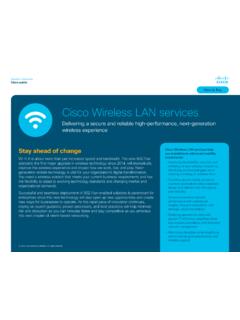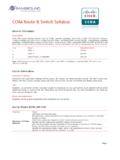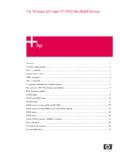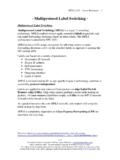Transcription of Miercom Report: Dual-Band Wave 2 Access Points ...
1 Dual-Band Wave 2 Access Points Comparative Performance: cisco Aironet 2800 and 3800 Aruba AP-335 DR160830 September 2016 Miercom Wave 2 APs: cisco 2800/3800 v Aruba 335 2 DR160830C Copyright Miercom 2016 12 September 2016 Contents 1 Executive Summary .. 3 2 Congestion and Interference at GHz .. 4 3 About the Products Tested .. 5 cisco .. 5 Aruba .. 6 Table 1: Dual-Band Wave 2 Access Points Tested .. 6 4 Test Setup .. 7 5 Maximum mGig and Dual-5-GHz AP Throughput Performance .. 10 6 Multi-Client Performance .. 12 7 Video Streaming .. 15 8 cisco FRA vs Aruba ARM .. 17 9 Spectrum Analysis: Interference Detection .. 21 10 Multi-User MIMO (MU-MIMO) .. 26 11 Dual External Antennas .. 28 12 Independent Evaluation .. 30 13 About Miercom .. 30 14 Use of This Report .. 30 Wave 2 APs: cisco 2800/3800 v Aruba 335 3 DR160830C Copyright Miercom 2016 12 September 2016 1 Executive Summary Miercom was engaged to perform independent, hands-on, comparative testing of IEEE Wave 2-based Wi-Fi Access Points from cisco Systems the Aironet 2800 and 3800 and the Aruba AP-335.
2 This report summarizes the comparative performance of these Dual-Band APs in the key areas of: throughput with up to 150 clients, maximum video-streaming clients, MU-MIMO support, auto radio-frequency-assignment abilities, and their ability to assess and adjust to interference. Key Findings: cisco s AP can dynamically change its radio to be a 5-GHz radio Only cisco s Dual-Band cisco Aironet AP can dynamically reconfigure its radio to be a 5-GHz radio and run both simultaneously, significantly increasing channels and 5-GHz device throughput. Better throughput performance with cisco In a typical Dual-Band environment, with both and 5-GHz radios operating, cisco achieved over 1 Gbps of AP throughput. Aruba posted a max AP throughput of just 714 Mbps under the same conditions. More clients can stream quality video with cisco AP The cisco Aironet 2800 can successfully stream cleanly watchable 5-Mbps video to more clients than the Aruba AP-335 can.
3 cisco s RRM out-performs Aruba s ARM in dynamic radio configuration cisco s Radio Resource Management (RRM) is better able to adapt to interference both in detecting interference and reconfiguring radios to minimize it than Aruba s Adaptive Radio Management (ARM). cisco AP s are managed as a unit, improving coverage cisco s Wireless LAN Controller manages all connected APs as a unit and can adjust power levels to maximize available frequencies. Aruba MU-MIMO spatial-stream support offers no advantage over cisco Testing found the Aruba AP-335s claimed support for four spatial streams can actually reduce aggregate throughput, offering no advantages over the cisco 2800 APs support of three spatial streams. Miercom independently verified key performance differences between cisco s 2800 and 3800 Access Points and Aruba Networks comparable AP-335. With cisco s performance exceeding Aruba s in the areas tested, we present the Miercom Performance Verified certification to the cisco Aironet 2800 and 3800 Wi-Fi Access Points .
4 Robert Smithers CEO Miercom Wave 2 APs: cisco 2800/3800 v Aruba 335 4 DR160830C Copyright Miercom 2016 12 September 2016 2 Congestion and Interference at GHz Most of the last decade, 2000 to 2010, saw an incredible proliferation of Wi-Fi and wireless devices, virtually all of which operated in the same GHz frequency band. Since wireless devices using this ISM (industrial, scientific and medical) frequency band don t need to be licensed, the same frequencies were also used in many other devices. These include microwave ovens, cordless phones and Bluetooth devices, including cordless keyboards, all of which may be deployed alongside Wi-Fi smartphone and laptop users in the same area at the same time and in the same GHz band. The result is congestion and interference, which diminishes Wi-Fi-client throughput. As a result, newer IEEE specifications, starting with in 2009, began extending Wi-Fi transmission into the 5 GHz band.
5 Devices can work in either band. There are only three non-overlapping channels usable by Wi-Fi devices in the GHz band, but 25 non-overlapping channels in the 5 GHz band. Subsequently, 5-GHz radio components came of age by 2010 and became economically competitive. The table below shows that many Wi-Fi devices today still operate in the GHz band. However, as new ones come to market and older ones are retired, more and more are operating at 5 GHz, a band featuring many more available non-overlapping channels, much less interference and, subsequently, significantly higher capacity. Frequency Use, by Wi-Fi Standard IEEE spec Frequency When supporting devices first delivered a GHz band Largely supplanted by and products b GHz 2000 g GHz 2003 n and 5 GHz 2009 ac 5 GHz only 2013 Source: Miercom ; chart is a compendium from various published sources, including IEEE and Wikipedia.
6 Invariably, APs today still need to support Wi-Fi devices to some extent, in addition to the growing number of 5-GHz devices. This has bred Dual-Band APs. The flexibility with which the AP can automatically detect and assign the appropriate frequency for the user environment is a key capability, one which we examined in this comparative testing. Wave 2 APs: cisco 2800/3800 v Aruba 335 5 DR160830C Copyright Miercom 2016 12 September 2016 3 About the Products Tested Most of this testing pitted the cisco Aironet 2800 against Aruba Networks AP-335 competitive, marketplace-leading, indoor, Wave 2 wireless Access Points (APs). Up to six of each vendor s APs were deployed in identical indoor test environments with up to 150 wireless client devices. As shown in the below table, the Aironet 2800 and 3800 are functionally the same in nearly all respects.
7 Both support two Gigabit Ethernet (1000 BASE-T), RJ-45-based copper uplinks, but only the Aironet 3800 model additionally supports cisco s Multigigabit Ethernet (mGig), which enables bi-directional transmission at up to 5 Gbps over widely installed Cat 5e copper cabling. To test maximum throughput per AP, the cisco Aironet 3800 model supporting Multigigabit Ethernet on the uplink was used. Aruba offers a similar capability with its AP-335, called a Smart Rate uplink port, and this capability was tested alongside the Multigigabit Ethernet support of the cisco Aironet 3800. The APs tested are described in more detail below. cisco The cisco Aironet 2800 model was used in all of the testing except one test case where the Multigigabit Ethernet uplink support of the 3800 model was employed. The features and capabilities of the 2800 and 3800 models are the same in all other respects.
8 cisco says that its 5-GHz radio supports a theoretical maximum of Gbps. And since both of the AP radios can operate at 5 GHz concurrently, the APs theoretical maximum throughput climbs to Gbps. The AP supports all Wi-Fi channel widths from 20 to 160 MHz and can dynamically switch between channel widths as the client environment and conditions require. cisco 2800 Models support internal or external antennas Aruba AP-335 Contains internal antennas Wave 2 APs: cisco 2800/3800 v Aruba 335 6 DR160830C Copyright Miercom 2016 12 September 2016 Aruba The Aruba Access Point tested, the AP-335, represents one of the vendor s top-of-the-line, Dual-Band APs as of the time of this testing. Aruba claims the AP-335 supports an aggregate peak data rate of Gbps. That is based on a max 1,733-Mbps throughput on the 5-GHz radio and an 800-Mbps theoretical max on its radio.
9 Unlike the cisco 2800/3800, however, Aruba s radio cannot alternately run as a 5-GHz radio. The Aruba AP contains 12 internal omnidirectional, Dual-Band antennas. Like the cisco AP, the Aruba AP-335 supports IEEE a, b, g and n devices, as well as Wave 1 and 2. The following table details the salient characteristics of the APs tested. Table 1: Dual-Band Wave 2 Access Points Tested Aruba AP-335 cisco Aironet 2800 & 3800 Processor, Memory dual-core processor, 256 MB RAM dual-core processor, 1 GB RAM Wave 2 RF Support Single-User (SU) and Multi-User (MU) MIMO Single-User (SU) and Multi-User (MU) MIMO Wi-Fi standards supported IEEE a, b, g, n, ac IEEE a, b, g, n, ac Antennas 12 internal, omnidirectional, Dual-Band antennas i and e models support internal or external antennas Channel support 20, 40, 80 and 160-MHz channels 20, 40, 80 and 160-MHz channels Dual-Band radios GHz and 5 GHz GHz and 5 GHz, both radios can run in 5 GHz concurrently Auto assignment of radios Adaptive Radio Management (ARM) FRA (Flexible Radio Assignment) 1000 BASE-T interfaces Two; supports LAG (aggregation of both links) Two.
10 Supports LAG (aggregation of both links) Higher-speed uplink over Cat 5e Supports a Smart Rate uplink port; can negotiate up to Gbps (Model 3800 only) Supports Multigigabit Ethernet (mGig), which can negotiate up to 5 Gbps Special features USB port, Bluetooth Low Energy Side-loading module port for future modules ( , security), USB port Wave 2 APs: cisco 2800/3800 v Aruba 335 7 DR160830C Copyright Miercom 2016 12 September 2016 4 Test Setup Test Bed Set-up The test bed included six wireless- Access -Point ceiling mounts positioned throughout the building, with associated Ethernet ports (Cat 6a cabling), for each vendor s APs. The APs were mounted below the drop ceiling. Both vendors gear six APs and the vendor s WLC (wireless LAN controller) were installed in the same locations, delivering the same coverage areas to the exact same deployment of client devices.















